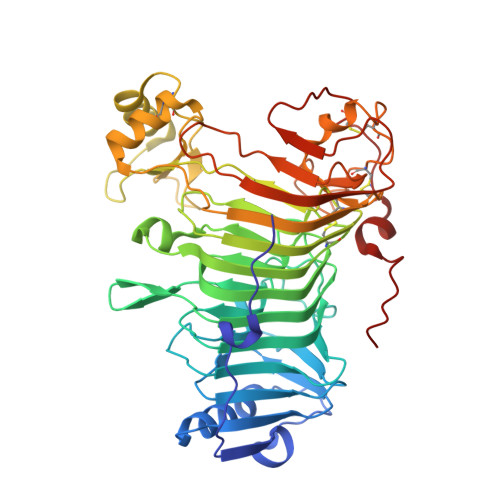Identification of catalytic residues and mechanistic analysis of family GH82 iota-carrageenases
Rebuffet, E., Barbeyron, T., Jeudy, A., Jam, M., Czjzek, M., Michel, G.(2010) Biochemistry 49: 7590-7599
- PubMed: 20681629
- DOI: https://doi.org/10.1021/bi1003475
- Primary Citation of Related Structures:
3LMW - PubMed Abstract:
Marine polysaccharide degrading enzymes, and iota-carrageenases in particular, have received little attention in the past, although their substrate specificity is of interest for biotechnological applications. This is mostly a consequence of the lack of data about their occurrence in the marine environment. Recent metagenomic data mining and the genome sequencing of a marine bacterium, Zobellia galactanivorans, led to the identification of three new iota-carrageenase genes belonging to the glycoside hydrolase family GH82. The additional sequences helped to identify potential candidate residues as catalytic proton donor and nucleophile. We have identified the catalytic key residues experimentally by site-directed mutagenesis and subsequent kinetic analysis for the iota-carrageenase from Alteromonas fortis CgiA1_Af. The kinetic analyses of the purified mutant enzymes confirm that E245 plays the role of the catalytic proton donor and D247 the general base that activates the catalytic water molecule. The point mutations of three other residues, namely, Q222, H281, and Q310 in A. fortis, located in proximity of the active site also affect the enzyme activity. Our results indicate that E310 plays a role in stabilizing the substrate intermediate conformation, while H281 is involved in substrate binding and appears to be crucial for maintaining the protonation state of the catalytic proton donor E245. The third residue, Q222, that bridges the catalytic water molecule and a chloride ion, plays a crucial role in structuring the water network in the active site of A. fortis iota-carrageenase.
- Université Pierre et Marie Curie and Centre National de la Recherche Scientifique, Marine Plants and BiomoleculesUMR 7139, Station Biologique, 29682, Roscoff, France.
Organizational Affiliation:



















